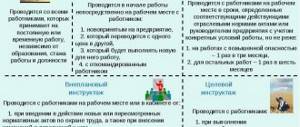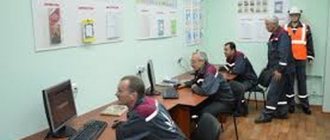It is legislatively established that the performance of job duties by employees must be subject to compliance with regulatory rules on labor protection. Compliance with the requirements of the law is possible not only by documenting the necessary instructions, contracts, etc., but also by allocating certain amounts to finance these activities.
The Labor Code of the Russian Federation establishes a provision on the amount of mandatory financial resources spent on carrying out planned occupational safety and health (OHS) measures.
List of measures to improve labor conditions and safety at the enterprise
An exhaustive list of actions that are planned to improve working conditions is fixed by the norms of Russian legislation. Among the most significant are the following:
- procedure for assessing current working conditions;
- modernization of production equipment;
- installation (installation) of a system for protecting equipment from external factors;
- modernization (improvement) of the employee notification and alarm system;
- providing all employees with special individual and collective protective equipment - protective clothing must be manufactured in Russia and only from domestic materials;
Funds are allocated in accordance with the established procedure
- labor safety training - in this case it is worth talking about existing hazardous production facilities and the obligation to train hired staff in accordance with the norms of Russian federal legislation;
- ensuring high-quality lighting in the workplace in accordance with developed standards;
- equipping medical stations with all the necessary equipment for high-quality examination and provision of primary care when necessary;
- arrangement of recreation areas in accordance with developed standards;
- installation of dispensers with high-quality drinking water in places where there are large concentrations of personnel and areas with high temperatures;
- Conducting regular medical examinations in accordance with the developed schedule and recommendations of the Ministry of Health.
The estimate depends on the developed set of measures
Reference! The proposed list is not exhaustive.
The full list is specified in Russian legislation and is for advisory purposes only. Additionally, it offers classifications directly into groups: organizational, sanitary, technical, general, private and individual.
Operating principles of the Social Insurance Fund
The main activity of the Fund is the provision of financial support for expenses for compulsory social insurance in case of temporary disability and in connection with maternity, for compulsory social insurance against industrial accidents and occupational diseases.
If we consider its activities within the framework of the relationship between employer and employee, then in simple terms this fund pays all expenses associated with injuries and occupational diseases received by employees in the workplace.
Where does he get the funds for this?
These funds come from the employer and amount to 2.9% of the employee’s salary. These deductions are required to be paid for each employee officially registered with you under an employment contract.
In addition, a so-called “injury contribution” is paid for each employee. That is, the rate is directly on insuring employees against accidents and occupational illnesses related to production activities. Its size is set in the range from 0.2% to 8.5%. It increases in proportion to the increase in the degree of risk to which the main activity of the enterprise is assigned.
All these parameters are established by law. At the moment, there are 32 tariffs, formed taking into account different areas of activity. They characterize different degrees of risk and the corresponding percentage of contributions.
The class to which an organization’s activities belong can be determined using two regulatory documents:
1) OKVED;
2) Classification of types of activities by risk, in accordance with Order N 851 of December 30, 2021 “On approval of the Classification of types of economic activities by occupational risk classes”
It is worth noting that accidents at work, as well as facts of identified occupational diseases, give the Social Insurance Fund the right to increase the “injury” coefficient for the organization.
Thus, each organization makes monthly contributions to the Social Insurance Fund for each employee in order to reimburse all necessary expenses from the fund in the event of an insured event.
How to make an event plan
There are no difficulties in the procedure for drawing up a plan. It is enough to use a standard sample to eliminate errors and misunderstandings with all the ensuing consequences.
What should the plan contain?
The main task of labor protection and its purpose
The standard form of the document is proposed by the norms of federal legislation. During the development of a corresponding project in order to improve working conditions on the territory of a particular enterprise, it becomes necessary to be guided by an approved planning system.
The standard structure of the plan requires that labor legislation be taken into account and include relevant information regarding the process of financing all previously planned activities, as well as a list of persons directly responsible for the implementation of the set goals.
Important! In most cases, those responsible are the immediate superiors of all existing structural units and other qualified specialists established by the standards of the Labor Regulations.
One of the most significant parts of the plan under consideration is the deadline for its implementation in general and a single set of measures in particular. During a scheduled inspection, authorized inspectors of the State Labor Inspectorate must verify information regarding labor protection costs with the available statistical reports for the previous reporting calendar year and information from the accounting department (accounting statements). The digital indicators must match.
What to consider when preparing your plan
The most important procedure is the correct preparation and approval of cost estimates for the next reporting calendar year. The amount of funds spent directly depends on the following factors:
- specifics of the enterprise's activities;
- the presence or absence of instructions from the state regulatory authority;
- the feasibility and need for a special assessment;
- a set of measures aimed at modernizing production equipment.
When developing, you should pay attention to the actual amount of financing
When drawing up a set of measures by a specially approved working group in order to determine a specific list of activities and simultaneously optimize them, it is necessary:
- Carefully analyze the set of measures that were implemented in the last reporting period in order to properly optimize.
- Analyze existing expenses.
- Draw up a detailed plan for the procedure - write down all the features. Each employee (his place) is necessarily taken into account - a set of measures can be recommended to specialists.
- Prepare a structured financial cost estimate.
- Coordinate and approve the estimate with senior management and heads of structural divisions of the company. Changes are made if necessary. In this case, financing will have to be done differently.
Before you begin the planning procedure and fill out the form, you need to analyze in detail:
- costs of labor protection and production of goods and services or other products;
- card of special assessment of working conditions;
- Section 8 of the Act on Investigation of Previous Accidents;
- all existing regulations of the authorized state supervisory authority without exception;
- signed contracts for the purchase of special personal and comprehensive protective equipment;
- established schedule for medical examinations;
- procedures for training hired staff.
Important! Thanks to the analysis, it is possible to realistically assess the upcoming costs and the likelihood of the occurrence of above-plan needs of the enterprise.
All of the above must be taken into account in the compiled estimate.
FSS decision
After submitting a package of documents for reimbursement of labor protection costs, approval takes place within 15 working days.
That is, now it becomes clear why you need to prepare documents in advance; three weeks is a long time.
Next, the adopted decision is formalized by the FSS within 3 working days as an order and can be delivered in person, sent by mail or electronically through the State Services portal. It all depends on which method you indicate in the application.
If the FSS approves financial support from insurance premiums, then you will then need to report for these funds (clause 12 of Order No. 580n).
By including future expenses in the plan, you may not be able to fully take advantage of them; in this case, the Social Insurance Fund must be informed by October 10 (clause 13 of Order No. 580n).
For the bonus received from the Social Insurance Fund, you will have to report quarterly by the 20th day of the next month following the expired quarter.
In order to complete the report, use the recommended form of Appendix No. 1 of the FSS letter No. 02-09-11/16-05-3685 dated 02/20/2017.
Along with the report, documents confirming the implementation of the declared activities are submitted. For example, if these are periodic inspections, then the final act, payment order, act of completed work.
The declared amount and the actual expenses must match penny to penny.
If the amount is a difference of 1 ruble, then your efforts may be in vain and you need to clearly control this important nuance.
How much funding is provided for occupational safety measures?
State management of labor protection: by whom is it carried out?
The amount of funding directly depends on the developed and simultaneously approved list of actions that are planned to be taken to improve the quality of work as a whole.
The amount of funds is determined by federal legislation
The employer has the right to finance compliance with the developed plan in the amount established by law.
Sources of financing for occupational safety measures
Art. 226 of the Labor Code of the Russian Federation describes in detail the standard mechanism for allocating funds to increase the level of safety of each hired worker.
Sources are:
- funds from the federal budget, as well as regional or local, with funding from extra-budgetary sources provided;
- funds from voluntary collections of organizations and employed persons (hired employees: electric and gas welder, engineer, etc.);
- employer funds.
Important! Each option has certain features, which will achieve an effect and significantly improve safety indicators in the future.
Financing of occupational safety measures from budget funds
Funds must be allocated to improve safety during the work in general. The procedure for organizing events is carried out at the expense of:
- state;
- territorial;
- regional budget, as well as numerous extra-budgetary funds.
The procedure is regulated by federal and regional legislation.
Reference! At the state level and local governments in particular, additional funds are being formed. The main task is to allocate additional funds if necessary.
Financing of labor protection measures at the expense of employers
Funds are allocated without restrictions on amounts. At the same time, the minimum is 0.2% of the amount spent on the production of goods and services.
Money to improve the level of safety of hired workers, for example, health improvement, special labor conditions, etc., can be increased in volumes solely in accordance with the norms of the collective agreement or other documentation.
Reference! Available cost indicators that are directly related to the financing of the program for improving the quality of work must be included in the calculation of tax fees in the cost of providing products, including their production, and services. Employees do not incur costs to implement assigned tasks.
It is strictly prohibited to spend funds from the occupational safety fund and allocate various materials from it for other needs if they are not included in the list.
In case of misuse, organizations are required to return the funds to the fund and additionally pay a fine in the prescribed amount. Ignoring the requirements will result in additional penalties.
Misuse of funds will result in a fine
In accordance with existing rules, additional funds may be allocated to improve the safety of employees while performing their job duties. For this purpose, it is allowed to use funds from insurance contributions and social contributions in particular.
This means one of the types of insurance, which is the organization of appropriate preventive measures directly with the aim of reducing the level of industrial injuries and the occurrence of occupational diseases, including the current procedure for the allocation of financial support. The rules operate on the basis of the norms of federal Russian legislation in accordance with the recommendations of the Social Insurance Fund.
Actions in the absence of funding
A detailed description of the responsibilities of each employee allows you to determine the degree of responsibility for the possible application of sanctions. The law provides for the punishment that an official may incur if he fails to comply with the requirements of the law on occupational safety. And the lack of funding in this case is not a mitigating circumstance or a way to avoid responsibility.
If the organization for some reason has not allocated funding for these activities, the manager can protect himself from issuing a fine (as on an official). To do this, you need to document requests for the allocation of funds for occupational safety measures from the management of the company/budgetary organization. In this case, information will be confirmed that the official (head of the organization) has made all possible attempts to obtain funding to comply with the requirements of the law. And if a fine is nevertheless issued, then in such a situation it is imposed on a legal entity.
From the point of view of the law, a fine is imposed on a legal entity when officials did everything in their power, and the action was not completed due to the fault of the legal entity. In this case, the lack of funding is an example of the guilt of a legal entity, when the proper person cannot do anything.
Judicial practice on financing of labor protection measures
The lack of an adequate level of funding for a company or other institution is not considered a valid reason for refusing to implement the developed set of measures, the main objective of which is to improve safety and comfort when performing work.
Important! If misappropriation of funds is detected, it is required to return them in full in combination with the paid fine issued by the authorized regulatory body. The Labor Code of the Russian Federation provides all sorts of levers of pressure on violators.
Calculation of the amount of funding for occupational safety measures
In accordance with the norms of federal Russian legislation, the period for calculation is the reporting calendar year. The legislation establishes the procedure for determining a system for determining the amount that can give a positive result, including economic (production growth, etc.) after the implementation of the set goals and objectives.
How financing of measures to improve working conditions and safety is carried out is specified in the legislation of the Russian Federation. Labor legislation provides for a minimum amount of financing (0.2 of the amount of production costs). Failure to comply with the rules will result in administrative liability with all the ensuing consequences.
Funding activities is a key step in improving occupational safety conditions. The procedure for calculating the required amount of funds is regulated by Russian legislation. In case of inappropriate use, administrative liability arises.
What amount can be used to finance preventive measures?
The amount of funding for each individual organization is calculated as 20% of the contributions accrued for the previous year minus the costs of paying support (these are sick leave and additional leave for work-related injuries or occupational illnesses) made last year.
For an organization with up to 100 employees that did not apply for financing in the two previous years, the amount is calculated as 20% of accrued insurance premiums minus the cost of paying security for the specified type of insurance for the three previous years.








